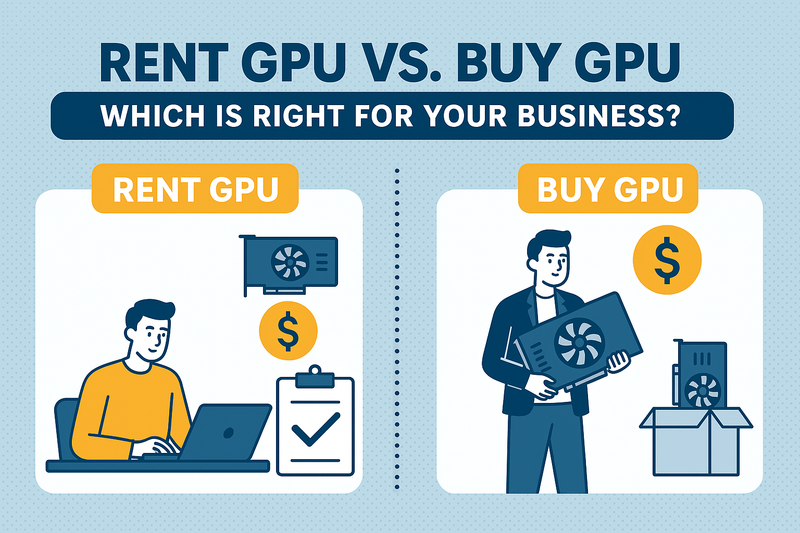In today’s fast-paced digital world, businesses relying on AI, machine learning, data processing, and 3D rendering need powerful GPUs (Graphics Processing Units). These computing workhorses are no longer limited to gamers or creative professionals—organizations in healthcare, finance, e-commerce, and SaaS all depend on GPU acceleration.
But here’s the big question: should your business rent GPUs from cloud providers or invest in buying them outright?** Both approaches have significant benefits and drawbacks, depending on your budget, scalability needs, and long-term goals.
This article breaks down renting vs. buying GPUs in detail, helping you make the smartest choice for your business.
The Case for Renting GPUs
Renting GPUs, often through cloud services like AWS, Google Cloud, Azure, or specialized GPU rental platforms, gives businesses flexible access to cutting-edge hardware without upfront costs.
Benefits of Renting GPUs
- Lower Initial Costs – You pay only for what you use, making it budget-friendly for startups and small businesses.
- Scalability on Demand – Need more power during peak workloads? Renting lets you scale instantly without new hardware investments.
- Access to the Latest Hardware – Cloud providers continuously update their GPUs, meaning you always get top performance without worrying about obsolescence.
- Global Accessibility – Teams across the world can access the same GPU resources through the cloud.
Drawbacks of Renting GPUs
- Recurring Costs – Over time, rental fees can add up, especially for businesses with ongoing heavy GPU use.
- Dependency on Providers – Your performance and uptime rely on the reliability of your rental service.
- Data Security Concerns – Sensitive industries (finance, healthcare) may find storing data in third-party systems risky.
👉 Renting GPUs is excellent for short-term projects, testing environments, startups, and businesses with unpredictable workloads.
The Case for Buying GPUs
Buying GPUs means owning dedicated hardware within your company’s infrastructure. This is a common choice for enterprises with continuous GPU demand.
Benefits of Buying GPUs
- Long-Term Cost Savings – If GPU use is heavy and constant, owning can be cheaper in the long run.
- Full Control Over Infrastructure – Businesses have complete authority over configurations, updates, and data security.
- No Dependency on Providers – You’re not tied to fluctuating cloud costs or service outages.
- Customization Options – You can build infrastructure tailored to your exact workloads (deep learning, 3D rendering, big data, etc.).
Drawbacks of Buying GPUs
- High Upfront Investment – Enterprise-grade GPUs like NVIDIA A100 or H100 can cost tens of thousands of dollars.
- Hardware Depreciation – Technology evolves quickly, and today’s best GPU could feel outdated in just 2–3 years.
- Maintenance Costs – Hardware requires electricity, cooling, and IT support.
👉 Buying GPUs is ideal for large enterprises, research institutions, and organizations running heavy AI/ML workloads daily.
Cost Comparison: Renting vs. Buying
| Factor | Renting GPUs | Buying GPUs |
|---|---|---|
| Upfront Cost | Low – pay per hour/month | High – thousands per GPU |
| Scalability | High – scale instantly in cloud | Limited – depends on hardware purchase |
| Long-Term Cost | Expensive if constant heavy usage | More economical for 24/7 workloads |
| Hardware Updates | Always latest via providers | Must reinvest in new GPUs |
| Control | Limited – provider restrictions | Full control over infrastructure |
| Best For | Startups, short-term projects, testing | Enterprises, research labs, heavy users |
Which Option Is Best for Your Business?
The decision ultimately depends on workload consistency, budget, and business size.
✅ Choose Renting If:
- You have short-term projects (AI model training, rendering tasks).
- Your workloads are seasonal or unpredictable.
- You want access to the latest GPU tech without upfront costs.
✅ Choose Buying If:
- You run constant, large-scale GPU operations.
- You need high-performance, secure on-premise infrastructure.
- Your budget allows for long-term hardware investments.
💡 For many businesses, a hybrid model—owning some GPUs while renting additional power during peak demand—is often the most cost-effective and flexible solution.
Conclusion
The Rent vs. Buy GPU debate isn’t about which is universally better—it’s about which aligns with your business strategy, budget, and scalability needs. Renting provides flexibility and lower upfront costs, while buying gives long-term savings and control.
- If you’re a startup or small business, GPU rentals can help you experiment and grow quickly.
- If you’re a large enterprise or research institution, owning GPUs can ensure stability, control, and better ROI over time.
In the end, the right GPU strategy can power your business to achieve faster innovations, better performance, and a stronger competitive edge.
Final Tip: Analyze your workload patterns, budget, and long-term goals before committing. Sometimes, the smartest businesses combine both strategies for maximum efficiency.




Top comments (0)